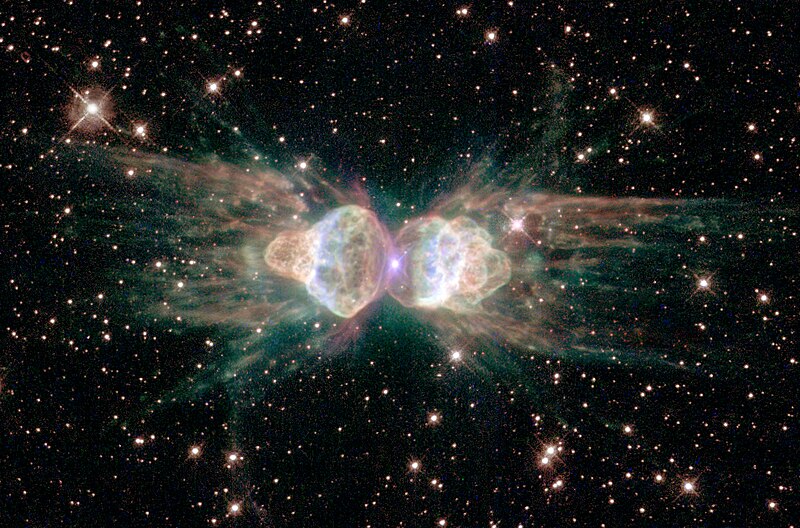File:Ant Nebula.jpg

Size of this preview: 800 × 528 pixels. Other resolutions: 320 × 211 pixels | 640 × 423 pixels | 1,072 × 708 pixels.
Original file (1,072 × 708 pixels, file size: 1.14 MB, MIME type: image/jpeg)
File history
Click on a date/time to view the file as it appeared at that time.
| Date/Time | Thumbnail | Dimensions | User | Comment | |
|---|---|---|---|---|---|
| current | 01:04, 1 February 2008 |  | 1,072 × 708 (1.14 MB) | Papa November | Full res version from source |
| 01:01, 1 February 2008 |  | 1,072 × 708 (148 KB) | Papa November | Uploaded full resolution image from source | |
| 14:30, 29 January 2008 |  | 600 × 362 (69 KB) | Nk | {{Information |Description=The Ant planetary nebula (Menzel 3 or Mz 3). STScI-PRC2001-05 This NASA/ESA Hubble Space Telescope image reveals the ant's body as a pair of fiery lobes protruding from a dying, Sun-like star. Though approaching the violence o |
File usage
The following 12 pages use this file:
- Astronomy
- List of planetary nebulae
- Mz 3
- Norma (constellation)
- Talk:Outline of physical science
- User:Exoplanetaryscience/sandbox
- User:King Zebu
- Portal:Astronomy/Picture/10 August 2005
- Portal:Astronomy/Picture/17 May 2005
- Portal:Astronomy/Picture/August 2005
- Portal:Astronomy/Picture/May 2005
- Portal:Astronomy/Picture/Week 01 2006
Global file usage
The following other wikis use this file:
- Usage on af.wikipedia.org
- Usage on an.wikipedia.org
- Usage on ar.wikipedia.org
- Usage on ar.wikiversity.org
- Usage on arz.wikipedia.org
- Usage on ast.wikipedia.org
- Usage on ba.wikipedia.org
- Usage on bg.wikipedia.org
- Usage on bjn.wikipedia.org
- Usage on bn.wikipedia.org
- Usage on br.wikipedia.org
- Usage on ca.wikipedia.org
- Usage on cbk-zam.wikipedia.org
- Usage on ce.wikipedia.org
- Usage on cs.wikipedia.org
- Usage on de.wikipedia.org
- Usage on en.wikinews.org
- Space shuttle Discovery cleared for Monday launch
- SpaceX Dragon spacecraft launches for the first time
- Expedition 26 crew blast off to space station
- Moon water possibly originated from comets, data shows
- DNA components found in meteorites
- SETI Institute set to re-open
- Out of space in outer space: Special report on NASA's 'space junk' plans
- Usage on en.wikiversity.org
- Astronomy college course/Astronomy (wikipedia)/questions
- Astronomy (wikipedia)/Quiz02
- Astronomy college course/Astronomy (wikipedia)/Quiz02
- OpenStax Astronomy/Test 1 Study guide
- Astronomy college course/Unit 1 study guide
- Wright State University Lake Campus/2017-1/Phy1060/printPDF
- Wright State University Lake Campus/2019-1/Phy1060/Old studyguide/Pdf
- Quizbank/All questions
- Usage on eo.wikipedia.org
- Usage on es.wikipedia.org
View more global usage of this file.


 French
French Deutsch
Deutsch
